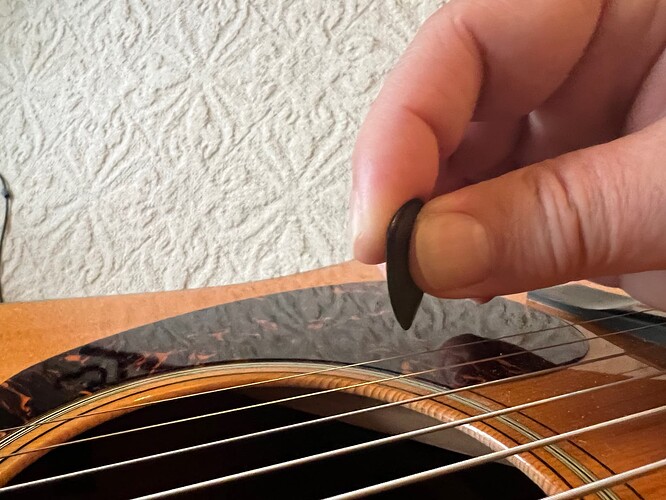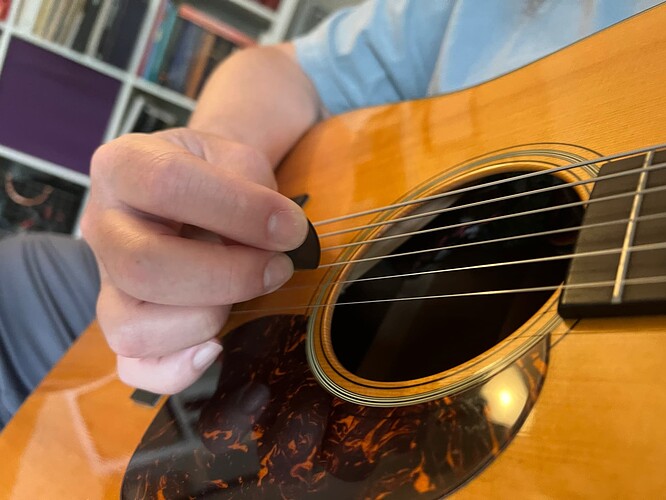Just wondering how many folks are working on this. I started working with RDT several months ago with a two-finger leading edge grip, and at first I found the three-finger trailing edge grip to be “sticky” on the strings. I’ve since been working on the trailing edge grip and it seems to be getting smoother. I think this shows promise to be the best of the motions I’ve tried. What say you?
Clarification- by “best” I mean the overall effort involved, the range of motion across all six strings, and the ability to do DBX like Steve Morse or Andy Wood.
Yeah, I’m working on this - seems to be going well. My trailing edge isn’t quite a 3 finger grip, it’s more of a 2 finger with a 3rd finger acting as a brace. I’m pretty pronated at the moment, although I’ll be working on flattening it out!
Is there anything in particular that you are working on that you’ve had a lot of success with? Or opposite to that, is there some stuff that’s kicking your butt? Either way I’d love to hear about it!
The biggest issue I’ve had is holding the pick such that there is a consistent level of friction between pick and string on both downstrokes and upstrokes, and across the six strings. It seems like I have to turn the pick to almost a 45 degree angle to the strings to get strokes to flow well. I also have to change the pick angle as I move across the strings, because my hand is moving in an arc from a single anchor point.
And then some days it seems to work great and other days not so great.
I’m going to open another technique critique soon, specifically on the trailing edge mechanic, and I’ll post a link to it here in the forum.
I’ve tried this but my thumb can not flex enough to angle the pick comfortably, I wish it could cus it looks cool, but whatever right…
I think usx with leading edge is the best and most basic technique that will work for almost anyone, as it’s just how our hands naturally relax and give the most muscular range of contraction. But it’s also standard and who likes that, thats not cool lol.
If you have to work on something it’s not very natural to your physicality, the best technique is what ever flows from the start, then you can really bring that to a high level. Maybe RDT trailing edge is like that for you? For me I want to do it but it would limit me a lot, I’ve accepted that I can’t do it effectively.
One guy who does do it naturally that perhaps you’ve seen or will get a kick out of is Joshua Jones - YouTube it’s a shame he keeps deleting his lives cus he was literally talking about it in the last live. He does severe RDT trailing edge especially When he does the evh tremolo picking.
@jllewi I think that any motion/setup will come with it’s challenges, that’s for sure! Although even if you just have a slight knack for whatever is natural to you - I think you owe it to yourself to pursue it and see what happens. This last few months for me has been a period of opening a lot of doors seeing what the options are if i commit to the setup! I have discovered that for every weakness, there is a sort of superpower when it comes to line execution and whatever one’s setup happens to be.
For me, I’d say that finding ways to optimize the setup and minimize unnecessary background tension have been my main priorities. I was lucky enough to have a coach/mentor to help me through that process, and sounds like you are also - you have the ctc guys!
Now for me, it dawned on me that even number of notes per string is the starting point for my picking, so I have really been focused on 2 and 4 nps at the moment. (2 NPS primarily to develop tracking!) For the “odd” nps, I do… something else hahaha sweep or hybrid or legato. But there’s a sort of light, effortless feeling that I am trying to maintain through all of my moves/strategies and often times, that led Tom (Tom Gilroy) and I to a discussion about the importance of reseting, and reviewing the setup. You know, making it a habit of finding the right setup every time, while simultaneously phasing out ineffective habits.
Hmm your pick angle thing… Is it because you are trying to supinate when your arm wants to pronate? Or is it where the actual pick is? Personally I treat the pick as a sort of extension of my fingernail in regards to placement. The point of the jazz III is kind of centred to my finger if that makes sense. Took me a while to get used to this!
Yeesh, sorry for the ramble I hope some of it helps?
I would recommend posting a video to demonstrate the issues you are having.
I do think though, that maybe you should experiment with using the arm to help with string tracking. Especially when tracking across all 6 strings. Again though, without a video it’s hard to problem solve.
I’e posted several TCs focused on leading-edge RDT. I’ll be submitting a new one soon, with trailing-edge RDT.
Hey man! I have a similar grip, but from the photos you have shared, I am a lot more pronated. In order for me to play using DSX while supinated, the only way I can think of how to do it is to sort of “dial” my pick.
Here’s me, hopefully it can provide some reference, and really hopefully it doesn’t lead you down a path of despair, anxiety and darkness. Stuff like that is the way of the dark side, turn you into a sith it will lol Seriously, though I hope it helps somewhat, good luck man!
Whats the advantage of trailing edge? Why do it?
For me, it just feels natural and it’s what I started with back in the paleolithic era. I later learned to play with a leading edge, and have done so for the last 20 years or so, but in an effort to defeat background tension I needed to make some changes…
I’ll try to summarize this very quickly, these are my assertions:
a) Reverse Dart Thrower is the most relaxed wrist motion with the greatest range across the strings without “tracking”, therefore I must find a way to do this
b) In order to do RDT you have to supinate your wrist to the ergo-mouse position
c) When I rotate to the ergo mouse position with my standard two-finger leading edge grip, the pick has moved away from the strings
d) So I have to extend my fingers to get the pick back down where the strings are. I am working with this grip now. But:
e) If I instead use the three-finger trailing edge grip (or my interpretation of it), that places the pick in the plane of the strings without the (somewhat awkward) extension of my fingers with the more standard two-finger grip.
I’m sure this would be better with Troy’s animations, but this is the best I can do on the spot.
Can you guys sweep with it? Thats one of the reasons I stopped.
Almost all grip choices have implications. Trailing edge grip features easy descending sweeps. You can do ascending too, but you’d have to tilt the pick a little. The same could be said for a supinated USX posture. Easy ascending sweeps, descending requires a tilt.
I think the closest posture that can do “everything” is the lightly supinated Andy Wood setup. And that’s not even entirely true as it can’t do continuous USX (or even ascending sweeps) without an adjustment. As versatile as that seems, that setup doesn’t come easily for everyone, so the best we can do is find what does feel easy for us and take that as far as we can.
Do you mean ascending sweeps?
RDT would be USX. Not DSX.
No, I mean descending. When I say “descending” I mean going from the higher sounding strings → to the lower sounding string. So, moving the pick up towards your chin. DSX postures do these very naturally because they often have an upward slant.
EDIT: I realize that’s confusing, since we’re moving our pick “up”, yet we’re calling it descending. My guitar students used to get confused when I’d tell them to move “up” the guitar neck and they’d move their hands toward the head of the guitar lol! I’d have to say, “no, the other up”. The notes go up when we move towards to the body. So in arpeggios, same deal. We’re talking pitch, not pick direction.
Have you seen the updated section in the Pickslanting Primer on RDT? It can do USX (and even DBX) but in most cases it’s DSX. RDT is what people like Andy James and Al Dimeola do. DT would be Shawn Lane, so USX. And also the upstroke part of the DBX that Molly Tuttle David Grier do is DT.
Your video is still processing. I’ll check it in a bit to see where we are disconnected lol 
I admit I’ve not seen the recent CTC materials. I’ve not been a paid member for a few years now. Not by choice btw lol.
The video is raw as always but explains my issue.
I do understand the inverted concept on guitar. Vid should show it, I did struggle with that at start too.




